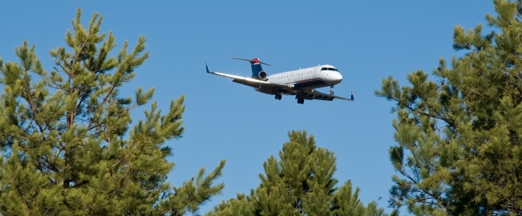New environmental metric delivering real results
4 June 2013With the rising cost of fuel and an increasing need to improve environmental performance, NATS set a target to reduce air traffic related CO2 emissions by an average of 10% per flight by 2020.
After several years of developmental work in collaboration with the NATS Environment team the 3D Inefficiency score (3Di) was developed so that every flight from 1st January 2012 would have a 3Di score calculated to further incentivise environmental improvements.
How does the 3Di work?
The 3Di metric measures air traffic efficiency by comparing the actual horizontal and vertical profile of each flight against the most efficient profile. Horizontally, this means comparing the actual distance flown with the most direct possible route. The inefficiency is defined by the additional miles flown.
In the vertical plane, the actual flight profile is compared against the airline’s preferred trajectory. Level portions of flight use more fuel at low altitude, so the vertical inefficiency is defined by the amount of time spent in level flight and the deviation from its requested cruise level. The metric applies different weightings for level flight in climb, cruise and descent in order to account for the varied rates of emissions performance across the different phases of flight.
All of these factors are combined to give a single 3Di score for each flight. The 3Di metric can be applied to any region of airspace to provide an estimate of that region’s fuel efficiency.
Targeting environmental improvements
At the end of each year all the 3Di scores are combined to give a single annual average score for NATS. Following consultations with airlines and the CAA, as well as computing the 3Di scores for the last few years in our network, a performance scheme has been set up to target improvements to the UK 3Di score.
A big factor behind this score is the underlying structure of our airspace. The busy and congested nature of UK airspace means that aircraft are not always able to obtain their most direct routes or most optimal climb and descent profiles. However, the 3Di metric has identified areas of inefficiency within the network and provided airspace designers with additional information to consider when planning future airspace structure.
The metric has also provided controllers with a more representative measure of their impact on environmental performance, leading to small day-to-day improvements towards an improved 3Di score – in turn reducing emissions and customer costs. The metric will help to drive reduced costs and is the first of its kind:
“NATS should be congratulated for the work done on 3Di Flight Efficiency Metric through which it leads its European peers. This is an innovative, industry leading piece of work.”
Paul Tate (Manager Flight Technical Services, British Airways)
Environmental plans for the future
Initially, NATS is driving improvement to meet regulated targets for the next 3 years. Its current 3Di score is close to 24 but if it is reduced to below 21 NATS is in bonus territory but if it goes above 27 there is a risk of a penalty. In 2014, the performance scheme tightens by one point, providing an even greater incentive to improve fuel efficiency.
The biggest improvements will be delivered through airspace design and operational changes, improving access to shared airspace and providing controllers with tools which enable them to achieve the desired outcomes. This is not easy to do owing to factors such as increasing volume of flights within the network, bad weather and limited runway capacity, leading to aircraft holding. Adapting to become more resilient to these external factors will help drive the 3Di score down.
CAA analysis suggests that if the targets are met over the next 3 years, NATS’ airline customers could save £120m with CO2 emissions in UK airspace reduced by over 600,000 tonnes.
To find out more about the 3Di visit http://www.nats.co.uk/environment/3di/
Comments
Please respect our commenting policy and guidelines when posting on this website.
